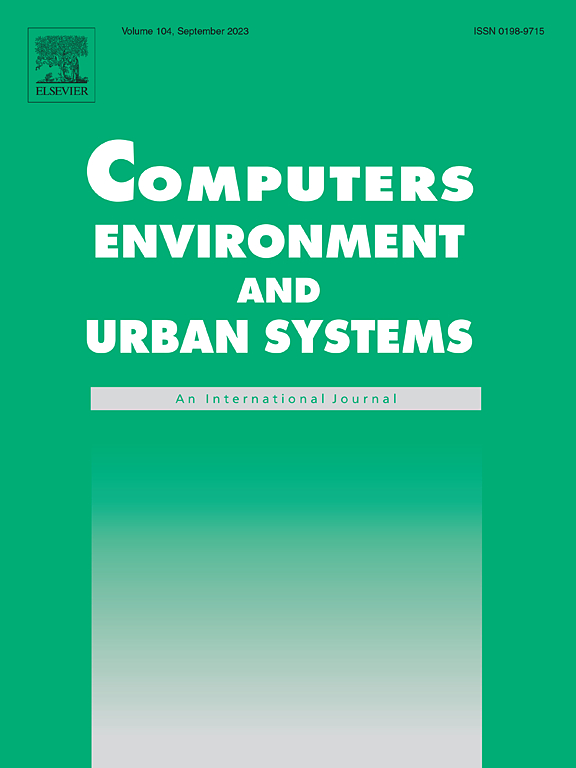量化自行车网络连接和自行车安全之间的关系:在加州两个城市进行的连接指标的比较分析
IF 8.3
1区 地球科学
Q1 ENVIRONMENTAL STUDIES
Computers Environment and Urban Systems
Pub Date : 2025-03-11
DOI:10.1016/j.compenvurbsys.2025.102271
引用次数: 0
摘要
为了鼓励人们使用自行车作为交通工具,城市正在将重点从建设孤立的自行车道转向建设互联的自行车网络。这些网络的有效性是通过它们的连通性来衡量的,特别是不同年龄和能力的人骑自行车到达目的地的容易程度。虽然大多数研究人员和政策制定者假设,连接良好的自行车网络可以为骑自行车的人提供更多的交通保护,从而降低车祸风险,但大多数研究发现,网络连接与自行车事故之间存在正相关或零相关。这种差异可能来自实际流程,例如高流量区域的客流量增加,或者来自如何测量连接性的可变性。我们的研究旨在通过解构和比较不同的指标,了解自行车安全与社区层面的各种连接性指标之间的关系。我们批判了先前仅依赖自行车基础设施的基于密度的度量结构,并引入了来自低压力网络的基于密度和基于路由的新度量。使用负二项回归模型,我们研究了加利福尼亚州圣巴巴拉和戈莱塔125个街区组的自行车事故与连通性指标之间的关系。我们发现,在自行车基础设施和低压力网络中,基于密度的连接性的增加与更少的交通事故有关。相比之下,基于路线的连通性措施(反映自行车到达主要目的地的情况)与交通事故呈正相关。我们得出结论,不同的连接指标可以改变连接-安全关联的方向。我们提出的指标,结合了低压力网络和路由算法,提供了更细致入微的理解连接如何与自行车安全相关。本文章由计算机程序翻译,如有差异,请以英文原文为准。
Quantify relationships between bike network connectivity and bike safety: A comparative analysis of connectivity metrics conducted in two California cities
To motivate people to use bikes for transportation, cities are shifting their focus from constructing isolated bike lanes to building interconnected bike networks. The effectiveness of these networks is measured by their level of connectivity, specifically how easily individuals of all ages and abilities can reach their destinations by bike. While most researchers and policymakers hypothesize that well-connected bike networks will reduce crash risk by offering bicyclists extended protection from traffic, most studies find positive or null associations between network connectivity and bike crashes. This discrepancy may arise either from actual processes, such as increased ridership in high-traffic areas, or from variability in how connectivity is measured. Our study aims to understand relationships between bike safety and various connectivity metrics at the neighborhood level by deconstructing and comparing different metrics. We critique previous constructs of density-based metrics rely solely on bike infrastructure and introduce new density-based and routing-based metrics derived from low-stress networks. Using a negative binomial regression model, we examine the association between bike crashes and connectivity metrics across 125 block groups in Santa Barbara and Goleta, California. We find that increased density-based connectivity in both bike infrastructure and low-stress networks correlates with fewer crashes. In contrast, routing-based connectivity measures, which reflect bike access to key destinations, are positively associated with crashes. We conclude that different connectivity metrics can alter the direction of connectivity-safety associations. Our proposed metrics, which incorporate low-stress networks and routing algorithms, provide a more nuanced understanding of how connectivity is related to bicycling safety.
求助全文
通过发布文献求助,成功后即可免费获取论文全文。
去求助
来源期刊

Computers Environment and Urban Systems
Multiple-
CiteScore
13.30
自引率
7.40%
发文量
111
审稿时长
32 days
期刊介绍:
Computers, Environment and Urban Systemsis an interdisciplinary journal publishing cutting-edge and innovative computer-based research on environmental and urban systems, that privileges the geospatial perspective. The journal welcomes original high quality scholarship of a theoretical, applied or technological nature, and provides a stimulating presentation of perspectives, research developments, overviews of important new technologies and uses of major computational, information-based, and visualization innovations. Applied and theoretical contributions demonstrate the scope of computer-based analysis fostering a better understanding of environmental and urban systems, their spatial scope and their dynamics.
 求助内容:
求助内容: 应助结果提醒方式:
应助结果提醒方式:


